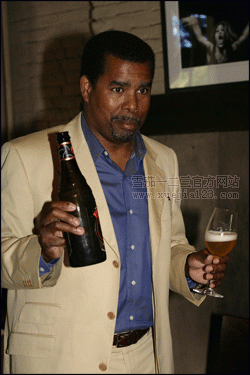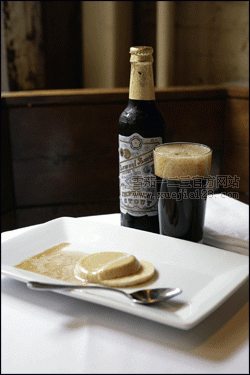More Adventures with Beer and Food
"We challenge you to think differently about beer," announced Craig Purser, the president of the National Beer Wholesalers Association, as he welcomed a variety of beer writers and distributors to 5 Ninth restaurant in Manhattan's trendy Meatpacking District.
It's becoming a common provocation in the beer world these days. The beer industry is intent on engaging beer consumers to see beer in a new light. It is encouraging beer drinkers to understand the nuances and ranges of flavors it provides, and to view beer not as the red-headed stepchild it's often perceived as, but as a product of quality craftsmanship that can offer the palate new experiences, especially when it comes to food.
"For me, the idea of cooking and eating is creative," said Garrett Oliver, the brewmaster and vice president of the Brooklyn Brewery and the author of The Brewmaster's Table: Discovering the Pleasures of Real Beer with Real Food. "Right now, a lot of people conduct their food life without really knowing what beer can do." But beer, he says, with its wide range of flavors -- from rich and toasty to light and delicate -- has the ability to turn an "ordinary dinner into something special." That isn't to say that wine doesn't have a place at the table. Instead, Purser and Oliver are encouraging people not to limit themselves by only drinking wine with a meal, especially when it means forcing a "wine to go where it doesn't want to go."
But where does one begin when pairing beer with food? "To have a successful match," writes Oliver in "The Principles of Beer and Food" chapter, "you'll want to match the impact of the beer [the strength of the beer's impression on your palate] with the impact of the food.
 Garrett Oliver, the brewmaster and vice president of the Brooklyn Brewery. Garrett Oliver, the brewmaster and vice president of the Brooklyn Brewery. |
Once balance is achieved, the next thing Oliver suggests is to set the flavor hook, which he describes as "the part of the beer that matches, harmonizes or accentuates the flavors in your food." Flavor hooks are the rich, caramel flavors in a pale ale or amber ale; the roasted malt flavors of a stout or porter; the intense hop flavors of India Pale Ale or Bavarian Pilsner, and the fruit and spice notes of a wheat beer. While harmony between flavors is the aim, contrasting flavors can also produce excellent pairings.
With that, Oliver teamed with chef Dan Parilla of 5 Ninth to create a menu that would best represent how beer and food can complement each other. Parilla came up with six courses, many of which included beer as an ingredient, while Oliver selected a style of beer he thought would pair best with each.
For starters, we enjoyed Béchamel grilled cheese and jalapeño poppers with Lagunitas India Pale Ale from the Lagunitas Brewing Co. in Petaluma, California. Extremely hoppy, with lots of pine and citrus notes, the IPA cut through the spiciness of the jalapeños, while the grilled cheese reduced a lot of the overpowering hops. Next came chilled Kumamoto oysters, prepared with Hitachino, a rice-based ale, and sansho pepper, and paired with Blue Moon, a Belgian-style white ale. The oysters could not have been better. The beer was light and crisp, with hints of coriander and orange, and that worked in harmony with the oysters without overpowering them or producing any funky fish notes.
Entrées followed, beginning with black pepper pork belly made with chili jam and stout. It was paired with Hex Nut Brown Ale from the Goose Island Beer Co. in Chicago, which was full of caramel and chocolate flavors and worked perfectly with the dish. The bitterness of the ale helped to cut through the fattiness. Next came seared black bass with strawberry salad and white balsamic gastrique paired with a new Belgian-style beer from the Brooklyn Brewery called Local 1. The beer is dry, high in alcohol (9 percent ABV) and bottle conditioned, and complements seafood beautifully. The carbonation acted as a wonderful palate cleanser, which can be necessary with any seafood dish, while the aromatics and alcohol content provided balance. It was also fruity enough to handle the strawberries. The final entrée was chorizo and squid poached in pilsner beer and served with tomatoes and micro herbs. The dish was paired with the original pilsner: Pilsner Urquell. Its bitter hops diffused much of the acidity from the tomatoes, while its bread and malt character and floral aromas refreshed the palate of some of the dish's spiciness.
The last dish, naturally, was dessert: panna cotta made with low-alcohol ginger brew and paired with Samuel Smith's Imperial Stout. The match was amazing. The roasted coffee flavors of the stout contrasted beautifully with the sweetness of panna cotta, while the sweet caramel and chocolate notes worked in harmony and weren't cloying in any way.
In the end, the pairings were fantastic, but begged the question: why has the concept of food and beer suddenly become the foremost topic in the beer industry at the moment? Oliver offers an excellent answer.
 Panna cotta made with low-alcohol ginger brew and paired with Samuel Smith's Imperial Stout. Panna cotta made with low-alcohol ginger brew and paired with Samuel Smith's Imperial Stout. |
"It's an exciting time to be a beer drinker in the United States," says Oliver, recalling the golden age of American beer brewing when, in the early part of the twentieth century, thousands of breweries dotted the American landscape. "People are realizing that it's weird to have only one type of beer and so are rediscovering beer culture. It's the new affordable luxury."
And one that more and more people are finding does just as well with food as wine does.
上一篇:Pilsner Urquell Pushes Beer and Food
下一篇:没有了

扫描微信,2014世界排名雪茄排名即将开启!
- 如何辨别假雪茄?
